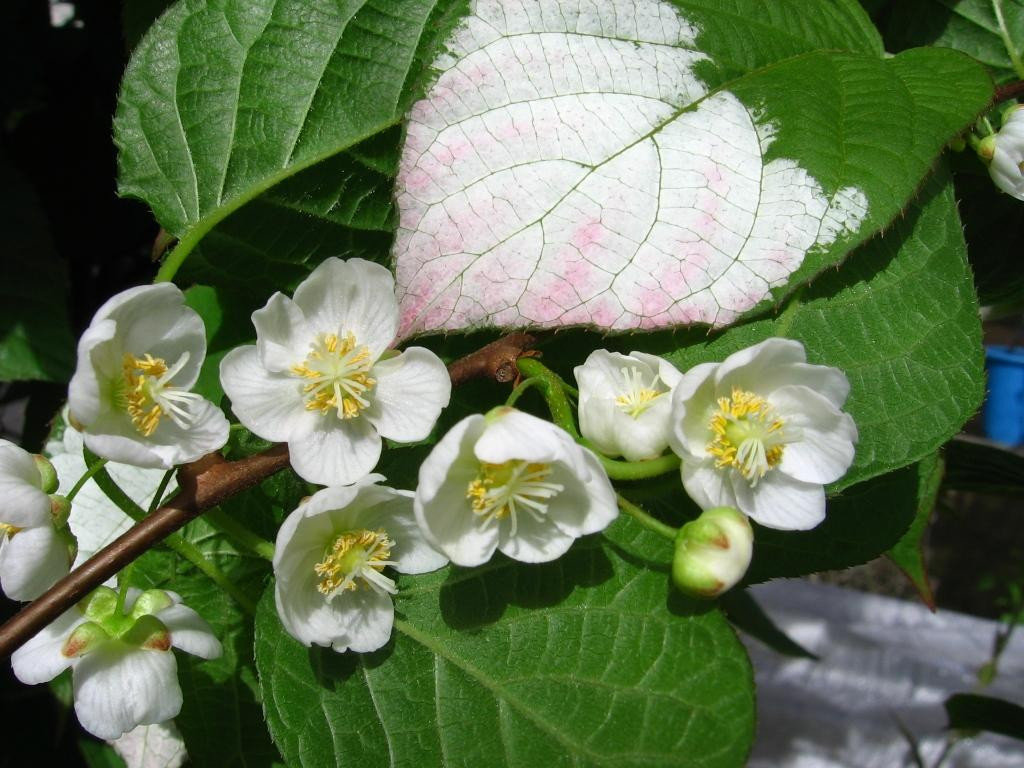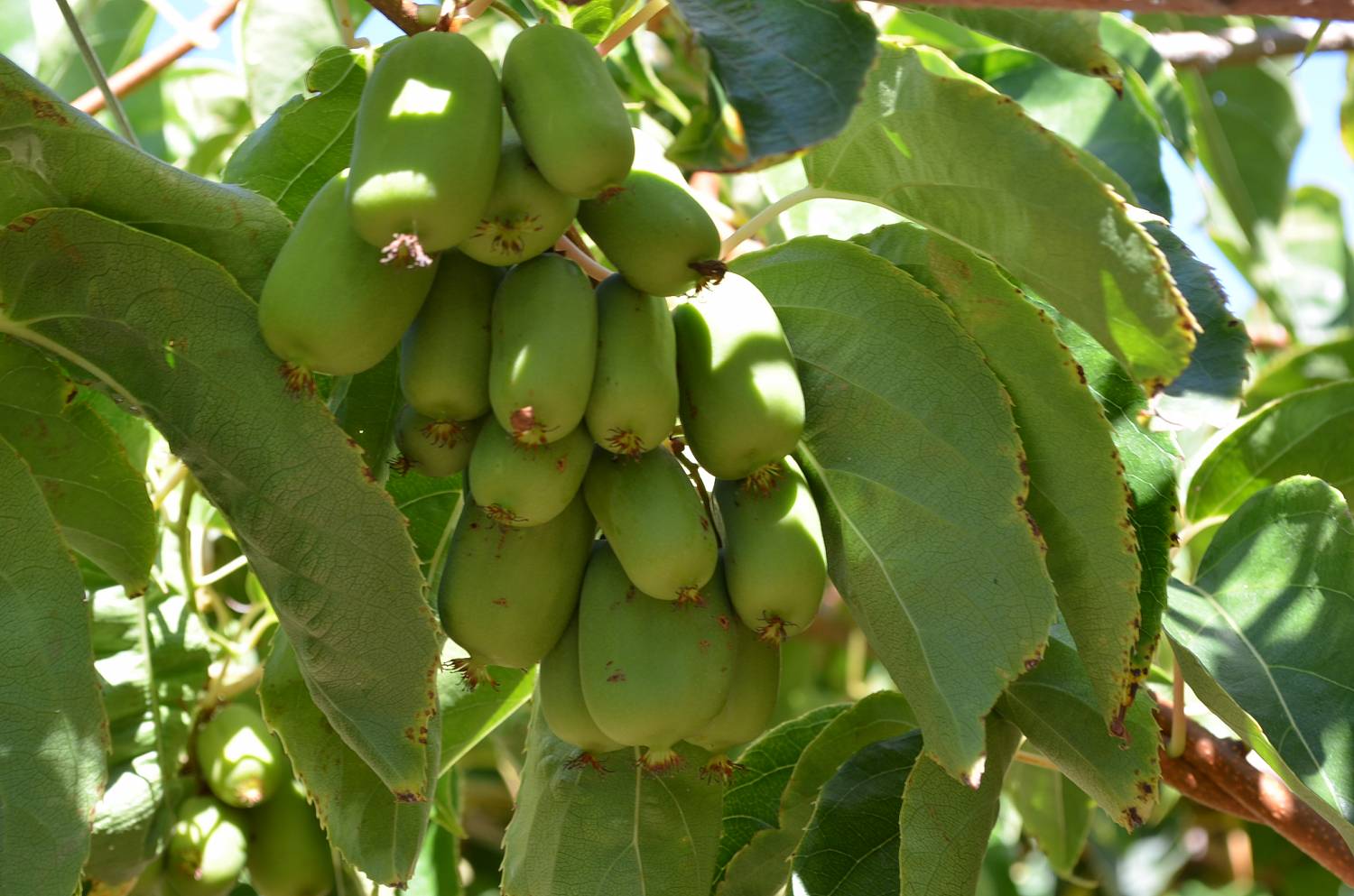Actinidia is a fairly resistant plant to various diseases, and harmful insects are also little interested in it, due to this, the berry is quite popular among domestic flower growers. Growing and caring for this plant is also not very difficult, and you will understand this if you learn more about this plant.
Content
Actinidia: landing features and description
The actinidia family has approximately 37 varieties, the natural habitat is Primorye, Far East, Japan, China, Sakhalin Island... In the conditions of a backyard for cultivation, four varieties are of interest as an ornamental and berry plant:
- Chinese;
- kolomikta;
- purple;
- argument.
One of the types of actinidia is also considered to be kiwi (a hybrid of kolomikta, Chinese and purple). Today there are many varieties and varieties of actinidia kolomikta with a fairly large number of berries.
Actinidia is a powerful tree-like liana with branches about 14-16 meters, trunk diameter 3-6 cm, winding around the frame counterclockwise. The bark is peeling, the shoots are brown, the new shoots are in the form of light lentilswith which the plant is fixed to the fence.
Leaves and fruits
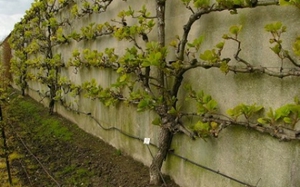 Actinidia leaves are quite large, thick, wrinkled, pubescent and quite attractive, because at different times of development, the vine changes its color. In spring, when new leaves are formed, their upper side is painted green-bronze, as they germinate, they get a bright green color, after which they darken. Before flowering - in early July, the tips of the leaves of this plant turn white, and for several days they cover almost the entire leaf.
Actinidia leaves are quite large, thick, wrinkled, pubescent and quite attractive, because at different times of development, the vine changes its color. In spring, when new leaves are formed, their upper side is painted green-bronze, as they germinate, they get a bright green color, after which they darken. Before flowering - in early July, the tips of the leaves of this plant turn white, and for several days they cover almost the entire leaf.
The flowers are white, large in size - up to 2 centimeters in diameter, located on long stalks, have a rather strong odor. The smell is similar to garden jasmine, intensifies towards evening and towards the rain, thus luring butterflies and bees. The flowering of this plant is quite long - up to one month. Pollinated by bees, good honey plant. When blooming, the bleached edges of the leaves take on a pink hue, and then become a bright crimson color, but some leaves can be silvery purple. The variegation and elegance of the painted parts of the liana depends directly on the degree of illumination - the location in the shade makes the color not so pronounced.
With the arrival of autumn, the plant becomes even more attractive - on one bush there are immediately crimson, pink, yellow, purple, bright brown colors.
Fruiting
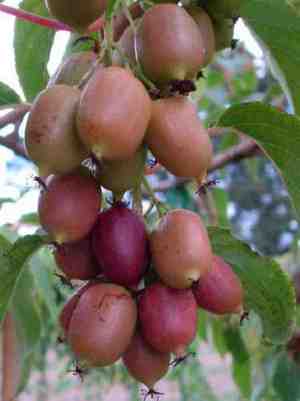 But our flower growers cultivate this magnificent plant not only for the beautiful foliage. The medium-sized fruits of actinidia are also quite valuable - a whole storehouse of vitamins, especially vitamin C, - its amount is 4 times greater than that of currants. It's not for nothing that actinidia is also called northern lemon.... The fruits of this plant are soft and oblong, weighing 5-7 grams, several centimeters long, during ripening they change color to a bright green, red, pink hue. There are up to 15 dark stripes along it. There are quite a lot of small seeds - about 100 pcs. in the berry.
But our flower growers cultivate this magnificent plant not only for the beautiful foliage. The medium-sized fruits of actinidia are also quite valuable - a whole storehouse of vitamins, especially vitamin C, - its amount is 4 times greater than that of currants. It's not for nothing that actinidia is also called northern lemon.... The fruits of this plant are soft and oblong, weighing 5-7 grams, several centimeters long, during ripening they change color to a bright green, red, pink hue. There are up to 15 dark stripes along it. There are quite a lot of small seeds - about 100 pcs. in the berry.
Fruiting occurs 7–8 years after planting this plant in a permanent place (but flowering sometimes occurs already at 4 years of age), approximately 7–9 kg of healthy and tasty berries can be obtained from approximately one plant.
It produces fruits stably for 32–37 years, with proper care and if the planting was carried out in the right place. The fruits do not ripen at the same time - first, those that are in the sun. Ripening continues, like flowering itself, up to one month. On some branches, ripe fruits crumble, therefore it is advisable to spread paper (or fabric).
Growing actinidia at home
In order for the cultivation and care of actinidia to be properly organized, you need to know certain features of its germination.
Germination conditions
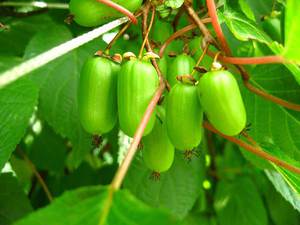 First you need to choose the right landing site. The shoots of the plant are stretched towards the sun, but here the root system absolutely does not perceive the drying out of the soil, since they are shallow - the main part is at a depth of up to 35 cm. Therefore, the landing site must be shaded in hot weather, and the actinidia itself is more like partial and slight shading.
First you need to choose the right landing site. The shoots of the plant are stretched towards the sun, but here the root system absolutely does not perceive the drying out of the soil, since they are shallow - the main part is at a depth of up to 35 cm. Therefore, the landing site must be shaded in hot weather, and the actinidia itself is more like partial and slight shading.
Actinidia soil is more like light (not clay or sandy), carefully loosened, you can add deciduous soil to the planting hole. it the plant does not tolerate strong moisture, therefore, should not be located at the landing site with a high location of groundwater. It is also not necessary to plant a vine near water bodies - the plant will die quickly.
Impact on other trees
Actinidia is a very aggressive shrub and significantly inhibits other plants in its sphere of influence. In addition, the roots of the liana are actively diverging to the sides and violate the root system of nearby trees. Because, planting this plant must provide her with approximately 7-9 square meters of "personal" space for food, which must be fenced in with dug sheets of slate or thick film.
There must be at least three meters of space to the neighboring trees. The best landing place is near the fence of the house, on a trellis near the path, near the arch. This has several advantages:
- convenient to harvest;
- the liana will not interfere with the rest of the plants;
- actinidia will make a great individual decoration.

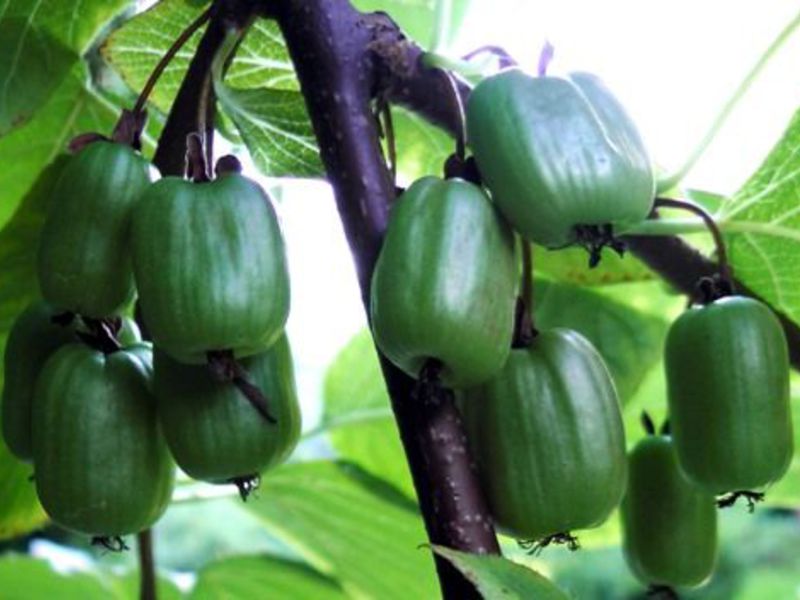
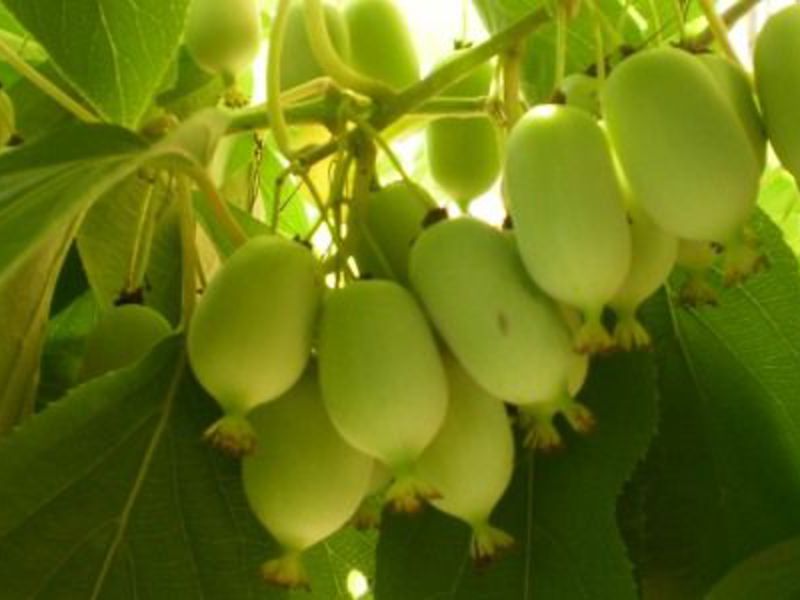

The most common mistake is that most people think that actinidia is a dioecious flower, like other varieties of lianas in this group. Yes, wild varieties that are grown from seeds are actually dioecious and you need to plant several plants nearby. Planting one male bush is enough for 7-9 female... But today's garden hybrids have bisexual inflorescences, and separate planting of a male plant is not considered optional.
How to grow actinidia from seeds?
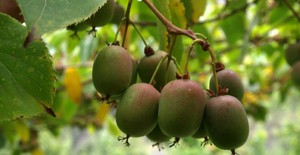 It is quite easy to do this, but still not necessary, since it is not clear before the first fruiting, which inflorescences will turn out - female or male. And you can plant up to 10 years, from which then there will be no use. In addition, even when fruiting appears, the berries will turn out to be tasteless and rather small. because it is best to choose a hybrid variety - you can buy it in garden stores or propagate it yourself - by shoots from a high-quality mother plant (bury a branch in spring and until autumn the shoot will take root). Or cuttings - in a small greenhouse.
It is quite easy to do this, but still not necessary, since it is not clear before the first fruiting, which inflorescences will turn out - female or male. And you can plant up to 10 years, from which then there will be no use. In addition, even when fruiting appears, the berries will turn out to be tasteless and rather small. because it is best to choose a hybrid variety - you can buy it in garden stores or propagate it yourself - by shoots from a high-quality mother plant (bury a branch in spring and until autumn the shoot will take root). Or cuttings - in a small greenhouse.
When to plant actinidia?
The pit for planting must be quite large - at least 75x75x75 cm.Drainage is laid out at the bottom - about 15 cm (gravel, expanded clay, crushed stone), then the pit is filled with soil of the following composition (in equal parts):
- humus or compost (you cannot add fresh manure);
- forest or coniferous land.
If the soil is heavy, add a layer of sand to the bottom of the pit. In the ground (for one hole) add about 1.2-1.6 kg of ash, 220 gr. superphosphate, 120 gr. potassium. In addition to fresh manure, it is prohibited to use lime and nitrogen-containing additives.
The landing of actinidia occurs in this way: in the middle of the depression you need to make a small hill, set it in seedling, its roots must be pre-processed - dip in a mixture of clay with a root growth activator (fumar, humate, epin, charkor). Sprinkle the hole halfway, make watering (a bucket per plant), then fill up the earth and tamp. It is necessary to insert the seedling in such a way that the neck of the root is in the ground by 3 cm.Then you need to build a temporary support and the planting site should be mulched by 6 cm with dry leaves or grass.
It is best to plant actinidia at such a time: in September (before the arrival of frost, the plant will take root) or in May.
Actinidia care
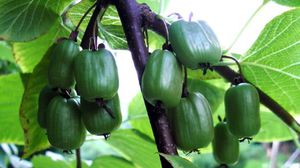 A clear sign that the plant has taken root is considered to be actively germinating branches in the first year after planting up to 2 meters. All care consists in regular watering, especially in the dry season and light loosening.
A clear sign that the plant has taken root is considered to be actively germinating branches in the first year after planting up to 2 meters. All care consists in regular watering, especially in the dry season and light loosening.
Main feature! Young shoots of this vine are very fond of nibbling cats (just as they love valerian). Because, nafter planting, the seedling must be protected for several years - wrap with a thin mesh of metal or plastic.
When actinidia is planted near a fence or other fence, then you just need to let it braid on its own. Or yourself install support, but not higher than 4 meters, since the height makes maintenance much more difficult. The wire is fixed from below at a distance of about half a meter above the ground, then every 80 centimeters.
Rows are best created from north to south - this way, the vine is better illuminated.
The creation of a bush is different - according to the type of vine:
- a fan-shaped formation of 6–7 seedlings evenly located over the entire surface, no more than 7–8 m long. In this case, in early August, you need to pinch the plant up to 60–80 cm. These sleeves are used for no more than 4 years, and for 3 they need to be prepared replacement;
- two-armed formation in two directions, where vertical shoots are created. These sleeves bear excellent fruit for about 20 years and then need to be renewed.
Pruning actinidia
Pruning is carried out in late autumn or with the onset of spring before the start of the juice movement. Moreover, it is necessary to remove dense, frozen or damaged branches, as well as all small branches. The tops are also cut off. The cut should be made 3 cm above the kidney.
Bait
Correct care certainly implies periodic feeding - about three times per season, otherwise the yield will be much less. For an adult liana at a time you will need about 120 gamma nitroammophoska (in spring), 160 grams of sodium sulfate (in July), and about 180 grams of superphosphate (in September). In addition, a couple of times in the summer, you can dilute the manure with water (about 120 grams per bucket) and water it at the very root.
Fruit processing
The readiness of the berries is judged by the softness of the fruit. You need to collect them every 4 days. The freshness of the fruit lasts only a few days. Ripe - the most delicious, they are processed in this way:
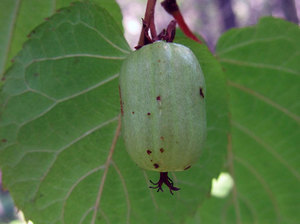 to make "raw" jam - transfer the fruits with a rolling pin and mix with sugar 1 to 2 (in a cold place can be stored for up to 4 years);
to make "raw" jam - transfer the fruits with a rolling pin and mix with sugar 1 to 2 (in a cold place can be stored for up to 4 years);- prepare wine: transfer overripe actinidia fruits and pour water in the same volume (it is impossible to make juice from berries). For a kilogram of fruit, you need to add 2 kg of sugar and set to ferment, then - according to the traditional method of making wine from grapes;
- dry - remove the stalks and dry at 60C for several days, the dried fruit looks like raisins;
- preserve compotes: a 3 liter bottle is filled by a third with washed fruits and filled with syrup - 360 grams of sugar per liter of water, sterilized with a water bath for half an hour;
- make jams - proportions 1: 1, bring to a boil three times, then place in hot bottles and roll up.
Actinidia is a very valuable raw material for soft drinks and vitamin drinks and extracts. Medicinal pectin elements found in large doses in actinidia berries, perfectly bind toxins and other toxic elements, as deposits of copper, lead, mercury salts, remove them from the body, contribute to the treatment of minor radiation injuries, which are associated with the intake of harmful isotopes into the body, the main amount of which comes out only with pectin elements.
